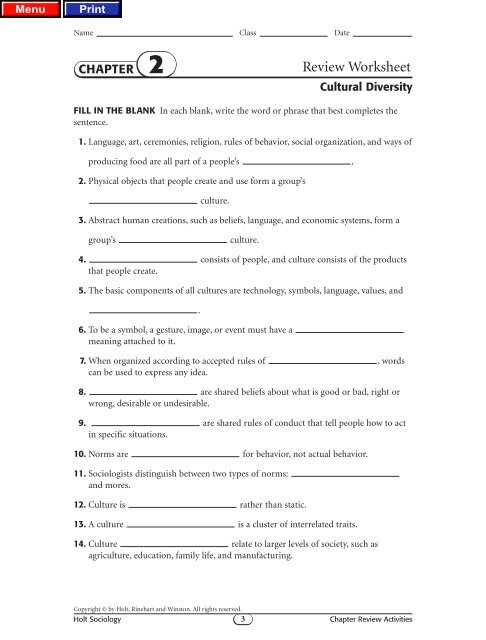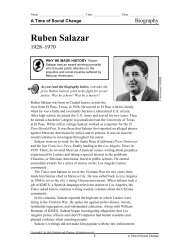Review Worksheet
Review Worksheet
Review Worksheet
You also want an ePaper? Increase the reach of your titles
YUMPU automatically turns print PDFs into web optimized ePapers that Google loves.
Name Class Date<br />
CHAPTER 2<br />
Copyright © by Holt, Rinehart and Winston. All rights reserved.<br />
<strong>Review</strong> <strong>Worksheet</strong><br />
Cultural Diversity<br />
FILL IN THE BLANK In each blank, write the word or phrase that best completes the<br />
sentence.<br />
1. Language, art, ceremonies, religion, rules of behavior, social organization, and ways of<br />
producing food are all part of a people’s .<br />
2. Physical objects that people create and use form a group’s<br />
culture.<br />
3. Abstract human creations, such as beliefs, language, and economic systems, form a<br />
group’s culture.<br />
4. consists of people, and culture consists of the products<br />
that people create.<br />
5. The basic components of all cultures are technology, symbols, language, values, and<br />
6. To be a symbol, a gesture, image, or event must have a<br />
meaning attached to it.<br />
.<br />
7. When organized according to accepted rules of , words<br />
can be used to express any idea.<br />
8. are shared beliefs about what is good or bad, right or<br />
wrong, desirable or undesirable.<br />
9. are shared rules of conduct that tell people how to act<br />
in specific situations.<br />
10. Norms are for behavior, not actual behavior.<br />
11. Sociologists distinguish between two types of norms:<br />
and mores.<br />
12. Culture is rather than static.<br />
13. A culture is a cluster of interrelated traits.<br />
14. Culture relate to larger levels of society, such as<br />
agriculture, education, family life, and manufacturing.<br />
Holt Sociology 3 Chapter <strong>Review</strong> Activities
Chapter 2, Chapter <strong>Review</strong> Activities, continued<br />
SHORT ANSWER Answer the questions in the space provided.<br />
15. Why did George Murdock examine hundreds of different cultures? ______________<br />
16. What did George Murdock believe about the purpose of the family? ______________<br />
17. What was the purpose of Margaret Mead’s classic study of cultural variation?<br />
18. Compare the general temperament of the Arapesh and the Mundugumor people.<br />
19. Compare the child-rearing practices of the Arapesh and the Mundugumor people.<br />
20. What did Mead conclude, based on her research? _____________________________<br />
21. What is cultural relativism and why is it important to social scientists? ____________<br />
22. How is a counterculture different from other subcultures? ______________________<br />
Copyright © by Holt, Rinehart and Winston. All rights reserved.<br />
Holt Sociology 4 Chapter <strong>Review</strong> Activities



